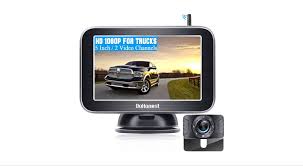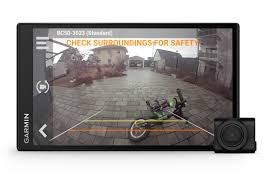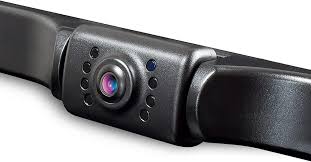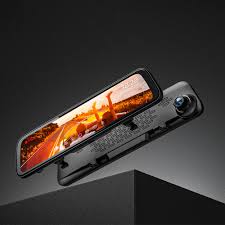Still relying on guesswork while reversing? You’re not alone—but it’s time for an upgrade. Rear cameras, once a luxury, are now an essential safety feature in modern vehicles. Whether you’re maneuvering into a tight parking space or ensuring pedestrian safety, a rear camera provides the clear visibility you need.
Why does it matter? A quality rear camera reduces blind spots, prevents costly fender benders, and makes daily driving safer and more convenient—especially for larger vehicles or new drivers.
In this guide, we’ll break down the best rear cameras for cars.
What Is a Rear Camera for Car?
A rear camera for car—also known as a backup camera or reverse camera—is a compact video camera mounted at the back of your vehicle. It automatically activates when you shift into reverse gear, displaying a live feed of what’s behind you on an in-dash or mirror-mounted screen.
How It Works
The camera captures a wide-angle view of the area directly behind your car. This feed is sent in real-time to a display unit, helping you reverse safely and accurately, even in tight spaces or poor lighting conditions.
Wired vs. Wireless Cameras
- Wired Rear Cameras: Offer a stable, lag-free connection, often built-in or installed professionally. Ideal for permanent setups.
- Wireless Rear Cameras: Easier to install, especially for DIY users. They transmit video signals via Wi-Fi or radio frequency but may be prone to interference.
Key Components
- Camera Lens: Mounted near the license plate, bumper, or tailgate.
- Display Monitor: Found on the dashboard, rearview mirror, or infotainment system.
- Sensors (Optional): Some systems include proximity sensors or parking lines for added assistance.
Benefits of Using a Rear View Camera
Improved Safety for Kids and Pedestrians
Blind spots can lead to tragic accidents—especially in residential areas. A rearview camera significantly increases rear visibility, helping drivers detect small children, pets, or obstacles that mirrors might miss.
Hassle-Free Parallel Parking
Struggling with tight parallel parking? Rear cameras provide clear visual guidance and optional trajectory lines, making parking smoother and stress-free.
Helps with Trailer Hitching
Aligning a trailer with your hitch can be frustrating. A rear camera gives you a precise view of your hitch point, reducing trial and error.
Legal Advantages in Some States
In many U.S. states, backup cameras are now mandatory in all new vehicles. Installing one in an older car not only enhances safety—it may also help meet legal standards and increase resale value.
Top Rear Camera Systems in 2025
Here’s a roundup of the best-performing rear view camera systems this year—covering everything from budget buys to premium picks for SUVs and night driving.
1. Auto-Vox V5PRO OEM Look Rear Camera System

- Key Features: 1080p resolution, built-in DVR, anti-glare mirror monitor, loop recording
- Pros: Sleek OEM-style mirror, parking assistance lines, clear night vision
- Cons: Slightly more complex installation
- Price Range: $170–$200
- Best For: OEM-style integration, luxury vehicles
- Amazon Rating: ⭐ 4.5/5 (2,800+ reviews)
2. LeeKooLuu LK3 Backup Camera and Monitor Kit

- Key Features: 720p resolution, 4.3″ LCD monitor, IP69 waterproof rating
- Pros: Very affordable, easy to install, solid performance
- Cons: Lower video resolution
- Price Range: $35–$55
- Best For: Budget buyers, compact cars
- Amazon Rating: ⭐ 4.4/5 (9,000+ reviews)
3. Furrion Vision S 7-Inch Wireless RV Backup Camera

- Key Features: Wide 120° viewing angle, motion detection, night vision, 7” display
- Pros: Super stable signal for RVs and trailers, great display
- Cons: Pricey for casual users
- Price Range: $400–$500
- Best For: RVs, trailers, large SUVs
- Amazon Rating: ⭐ 4.6/5 (6,700+ reviews)
4. DoHonest V25 Wireless Backup Camera

- Key Features: 1080p resolution, IP69 waterproof, 5″ monitor, no interference signal
- Pros: Great image quality, no signal delay, excellent for trucks/SUVs
- Cons: Monitor brightness could be better in full sunlight
- Price Range: $100–$140
- Best For: Wireless install, mid-range budget
- Amazon Rating: ⭐ 4.5/5 (13,000+ reviews)
5. Garmin BC 50 Wireless Backup Camera

- Key Features: Works with Garmin GPS displays, 720p camera, rugged weatherproof build
- Pros: Seamless integration with Garmin navigators, easy to use
- Cons: Only works with Garmin GPS units
- Price Range: $150–$200
- Best For: Garmin GPS users, clean wireless setup
- Amazon Rating: ⭐ 4.3/5 (1,900+ reviews)
6. eRapta ERT01 720p Rear View Camera

- Key Features: 149° angle lens, LED lights, universal fit, IP69 rating
- Pros: Under $30, durable, solid performance for price
- Cons: No display monitor included
- Price Range: $20–$30
- Best For: DIY installs, upgrading stock display
- Amazon Rating: ⭐ 4.4/5 (15,000+ reviews)
7. Wolfbox G840S 12″ Mirror Dash Cam with Backup Camera

- Key Features: Dual dash + rear camera, 2.5K front, 1080p rear, 12″ touchscreen mirror
- Pros: Dual function, ultra-wide view, easy to navigate
- Cons: Mirror may reflect glare if not angled properly
- Price Range: $160–$190
- Best For: Dash cam integration, large displays
- Amazon Rating: ⭐ 4.6/5 (8,300+ reviews)
Wired vs. Wireless Rear Cameras
When choosing a rear camera system, one of the first decisions you’ll face is whether to go wired or wireless. Each option has its strengths depending on your vehicle type, installation skill, and performance expectations.
Wired Cameras
- Pros:
- Stable video feed with no signal lag or dropouts
- Ideal for long vehicles like RVs or trailers
- Often delivers higher video quality
- Cons:
- Requires professional or DIY installation
- May involve drilling and routing cables through your car
Wireless Cameras
- Pros:
- Easy to install, especially for beginners
- Great for modern cars with existing display screens
- No need to run long cables through the cabin
- Cons:
- Prone to interference from other wireless devices
- Slight lag possible in real-time feed (especially in older systems)
- Can struggle in extreme weather conditions if not IP-rated
Pro Tip: If you drive a compact car or sedan and want a quick upgrade, go wireless. For trucks, RVs, or if reliability is your top priority, wired is the way to go.
Features to Look for When Buying
Not all rear cameras are created equal. To get the best value and performance, consider these key features:
Resolution
- 720p: Basic clarity; budget-friendly
- 1080p: Most common choice; great balance between quality and price
- 2K/4K: Ultra-clear detail; best for large screens or night use
Field of View (FOV)
- Look for 120° to 170° viewing angles
- Wider FOV reduces blind spots and gives better parking precision
Low-Light/Night Vision
- Choose cameras with infrared LEDs or Sony STARVIS sensors
- Important for reversing in dim alleys, garages, or at night
Waterproof Rating
- Essential for exterior-mounted units
- Look for IP67 or IP69K for protection against rain, dust, and road debris
Screen Type
- Dash Display: Compact, often placed near the console
- Rearview Mirror Display: Replaces or clips onto existing mirror
- Smartphone App: Wireless cameras that connect via mobile apps
Installation Compatibility
- Check compatibility with:
- Vehicle size & voltage (12V systems common)
- Display type (built-in infotainment vs. aftermarket screen)
- Mounting location (license plate frame, tailgate, bumper)
Best Rear Camera by Car Type
Different vehicles have different needs when it comes to rear visibility. Here’s a breakdown of the best rear cameras suited for each type of vehicle in 2025:
Best for Sedans
Recommended Model: Auto-Vox T2 Backup Camera Mirror Kit
- Key Features: Mirror monitor, 1080p video, easy clip-on install
- Why It’s Great: Seamless integration with factory look, perfect for tight parking
- Price Range: $90–$130
- Best For: Daily drivers, city commuters
Best for SUVs
Recommended Model: LeeKooLuu LK3 HD Wireless Backup Camera
- Key Features: 1080p resolution, wide-angle view, wireless install
- Why It’s Great: Handles higher ride height and broader body of SUVs
- Price Range: $110–$150
- Best For: Families, suburban and off-road drivers
Best for Pickup Trucks
Recommended Model: Haloview RD7 Wireless System
- Key Features: Long-range wireless (up to 984 ft), rugged design, 7″ monitor
- Why It’s Great: Ideal for trucks with trailers or extended beds
- Price Range: $180–$250
- Best For: Towing, construction, rural driving
Best for RVs
Recommended Model: Furrion Vision S 7” Wireless RV Backup Camera
- Key Features: Anti-interference signal, night vision, rear + side camera support
- Why It’s Great: Designed for RV scale and complexity
- Price Range: $450–$550
- Best For: Motorhomes, travel trailers, fifth wheels
Best for Electric Vehicles (EVs)
Recommended Model: DoHonest S4 Backup Camera with USB Power
- Key Features: Powered via USB or lighter port, HD video, no hardwiring
- Why It’s Great: Non-invasive install, perfect for EVs where wiring can be tricky
- Price Range: $100–$140
- Best For: Tesla, Nissan Leaf, Chevrolet Bolt, and other EV owners
Tip: Always check voltage compatibility and available display integration before buying a camera for your specific vehicle type.
Installation Guide: How to Set Up a Rear Camera in Your Car
Installing a rear camera might seem complex, but with the right tools and guidance, it’s totally doable—even for beginners.
Basic Tools Needed
- Screwdriver (Phillips and flat-head)
- Power drill (for wired setups, if routing through panels)
- Wire strippers & crimpers (for wired connection)
- Electrical tape or heat-shrink tubing
- Zip ties for cable management
Common Mounting Locations
- License Plate Frame: Most common and easy to access
- Rear Bumper: Offers a lower, wider angle
- Tailgate or Hatch: Ideal for SUVs, trucks, and RVs
Tip: Make sure the camera has a clear view and is angled slightly downward.
Display Setup: Wired vs Wireless
Wired Camera Setup:
- Run the video cable from the camera to the front display (usually a dash monitor or head unit)
- Connect power to reverse light wire (camera activates when reversing)
Wireless Camera Setup:
- Connect the transmitter to the camera at the back
- Plug the receiver into the display monitor
- Power from reverse lights or 12V socket (depending on model)
Wireless systems are quicker to install, while wired ones offer more stability and no signal interference.
Safety & Calibration Tips
- Test the camera before fully mounting it
- Use calibration lines (if available) to adjust viewing angle
- Avoid placing the camera near moving parts or exhaust
- Secure all wiring to prevent rattling or damage
- Re-check image quality and display sync before finalizing
Helpful Video Tutorial
Watch This Step-by-Step Guide:
➡️ How to Install a Backup Camera in Any Car – YouTube
Where to Buy Rear Cameras
Whether you’re looking for convenience, affordability, or expert help with installation, here are the best places to buy a high-quality rear camera for your car in 2025:
Amazon – Best Selection & Reviews
Why buy here:
- Huge variety of brands and models
- Verified buyer reviews and star ratings
- Frequent discounts and Prime shipping
Top brands available: eRapta, AUTO-VOX, LeeKooluu, DoHonest
Best for: DIY shoppers, quick delivery
AutoZone / Walmart – Local Pickup Options
Why buy here:
- Pick up in-store on the same day
- Trusted retail brands
- Occasional bundle deals with auto accessories
Best for: In-person shoppers, basic camera kits, budget buyers
Best Buy – Installation Services Included
Why buy here:
- Option to bundle camera purchase with professional installation
- Expert staff can recommend the right system for your car
- Access to premium brands
Best for: Non-tech-savvy users, premium systems, warranty protection
Direct from Brand Websites
Top brands:
Why buy here:
- Direct warranty support
- Exclusive bundles and accessories
- Latest model availability
Best for: Brand-loyal customers, those seeking manufacturer deals
Real-World Testimonials & Reviews
Before buying a rear camera system, hearing from real users and experts can help you make the right decision. Here’s what people are saying:
Reddit User Experiences
“Installed a LeeKooluu camera on my 2015 Tacoma — super clear view and made hitching my trailer way easier.”
– u/TruckGuy_89 on r/MechanicAdvice
“AUTO-VOX wireless cam worked flawlessly on my wife’s SUV. Took 30 minutes to set up, and no wiring nightmare!”
– u/GadgetDad on r/CarAV
Reddit communities are often a goldmine for honest, real-world feedback — especially from DIYers and car mod enthusiasts.
Amazon Verified Buyer Feedback
AUTO-VOX W7 Rearview Cam
⭐⭐⭐⭐⭐ 4.6/5 (3,200+ reviews)
“Excellent night vision and super easy to install. I’m not very handy, but I managed in under an hour.”
LeeKooluu Backup Camera Kit
⭐⭐⭐⭐ 4.4/5 (8,000+ reviews)
“Affordable and surprisingly good quality for the price. Works perfectly on my Jeep Wrangler.”
eRapta ERT01 1080p Wired Cam
⭐⭐⭐⭐⭐ 4.7/5 (10,000+ reviews)
“Hardwired it into my dash unit. The image is crisp, even in the rain. Great camera for under $50.”
Mechanic & Expert Reviews
“For long-term reliability, I always recommend wired cameras like the eRapta ERT01. Less chance of interference, especially in busy urban areas.”
– Mike Harris, ASE Certified Mechanic & YouTube Auto Reviewer
“Wireless systems have come a long way. The AUTO-VOX W7 is a great plug-and-play option for sedans and SUVs.”
– Lauren Vega, Auto Accessories Blogger at TechGearDrive
Takeaway: User reviews and expert input consistently highlight the importance of clear video quality, easy installation, and weatherproof design. Don’t just trust specs — trust experience.
Queries related to Rear Camera for Cars
Backup Camera for Car Installation
- How to Install: Installation typically involves mounting the camera, wiring it to the reverse light for power, and connecting it to the display screen. If it’s a wired system, you’ll need to route cables through the car’s interior, which may require professional assistance. For wireless systems, installation is more straightforward but still requires pairing with the screen. Always follow manufacturer guidelines, and if you’re unsure, consider a professional installation.
Wireless Rear Camera for Car
- Pros: Wireless backup cameras are easy to install, with no need to run wires through the car, making them ideal for DIY installations. They also offer flexibility, as you can mount them in various places on the car.
- Cons: Wireless cameras can suffer from signal interference, especially if your car has thick glass or metal components that may block the signal. Battery-powered models also need charging, and the wireless signal can sometimes have a slight delay or lower image quality.
Best Rear View Camera for Car
- Features to Look for:
- Resolution: Aim for at least 720p for clarity. Higher is better (1080p or 2K for even more detail).
- Wide Angle: A 120° to 170° field of view ensures you capture as much of the surroundings as possible.
- Night Vision: Look for cameras with IR LEDs or night vision to improve visibility in low-light situations.
- Waterproofing: Ensure it has a high IP rating (like IP67) to withstand weather conditions.
Popular models: eRapta, AUTO-VOX, Furrion, and Garmin offer excellent options for car rear-view cameras.
Best Wireless Rear Camera for Car
- Top Picks:
- AUTO-VOX T1400: Offers a wireless solution with a good viewing range and is praised for its ease of installation.
- Garmin BC 30 Wireless Backup Camera: Known for its integration with Garmin GPS units, providing a seamless experience.
- LeeKooluu LK3: Great for those seeking a high-quality wireless system with an affordable price tag.
Pros: No need for invasive wiring, easy to install, typically designed for easy-to-mount positions. Cons: Can experience signal interference, potential lag in the video feed, and battery life might be a concern depending on the model.
Backup Camera for Car with Screen
- What You Need: A backup camera with a screen is typically part of a full system kit (camera + display unit). The screen can either be a separate monitor that mounts on your dashboard or mirror, or it can integrate into the car’s existing display system.
- Monitor: Look for 5-inch to 7-inch screens with clear resolution and easy navigation.
- Mirror-Mounted Displays: These are very popular as they function as both a rearview mirror and a display, saving space and maintaining the look of your car.
Rear Camera for Truck
- Considerations:
- Trucks, especially large ones, benefit from wide-angle lenses and higher resolution for better depth perception.
- Wireless systems are great for trucks that might not have easy routes for wiring.
- Cameras should also have night vision since trucks often deal with loading/unloading at night or in dimly lit areas.
- Heavy-duty mounting is important to ensure the camera stays in place under rugged conditions.
Rear Camera for Car Near Me
- Where to Buy Locally:
- Auto Parts Stores like AutoZone or Advance Auto Parts often have a variety of backup cameras in stock.
- Best Buy or Walmart also carry a range of cameras and might offer installation services.
- Check local electronics or car accessory shops for professional help and direct product availability.
Back Up Camera for SUV
- Considerations for SUVs:
- SUVs have a higher profile, making it harder to judge distances in reverse. Look for cameras with higher resolution, wide-angle lenses, and good low-light performance.
- SUVs often have more storage, which could be an advantage when installing the camera. Wireless models are a good option for clean, easy installation.
Are There Any Pro’s and Con’s to Mounting a Backup Camera on the Inside (Behind the Glass) of My Car?
Pros:
- Discreet Look: Mounting the camera behind the glass keeps it out of view, giving a cleaner, less noticeable appearance.
- Protection: Keeps the camera shielded from the elements like rain, dust, or direct sunlight, reducing wear and tear.
Cons:
- Reduced Visibility: Glass can distort or reflect images, potentially reducing the quality of the video feed.
- Limited Field of View: The camera may not capture a full, clear view due to glass obstructions like rear-window wipers or defrosters.
- Installation Complexity: It may be trickier to mount behind glass as you’ll need to ensure it’s in the proper alignment for optimal viewing.
Premium Aftermarket Backup Camera
- Premium systems typically come with better video quality, higher durability, and advanced features like wireless connectivity, automatic calibration, and integration with existing screens. Furrion and AUTO-VOX offer high-end options that cater to more professional setups.
Looking for a Full-Time Rear-View Camera
- A full-time rear-view camera would continuously display the view from behind your vehicle, even when not in reverse. Some newer cars feature this as part of their infotainment systems, but it’s also available as an aftermarket installation for older vehicles.
- Best options: Look for systems with wide-angle, HD resolution, and night vision for full-time monitoring.
Has Having a Rear Camera Ever ACTUALLY Mattered for You? Or Anyone You Know?
Yes! Many people find rear cameras essential for:
- Preventing accidents: It helps avoid collisions with pedestrians, especially in crowded parking lots or when reversing in tight spaces.
- Towing: Rear cameras are incredibly useful when backing up trailers, making hitching and towing much easier.
- Safety: For families, especially those with kids or pets, the rear camera ensures there’s no blind spot, preventing accidents.
While many drivers initially find the cameras a luxury, they quickly become a critical tool that enhances safety, convenience, and overall driving confidence.
FAQ’s on Rear Camera for Cars
1. Are Rear View Cameras Worth It?
Yes, rear view cameras are definitely worth it for most drivers. Here’s why:
- Enhanced Safety: Rear view cameras significantly reduce blind spots, helping you avoid accidents, especially when reversing in tight spaces or parking lots.
- Improved Parking Accuracy: They make parallel parking and backing into spaces easier and more accurate, especially in busy areas.
- Pedestrian Protection: They help prevent accidents involving pedestrians, pets, or small objects behind your vehicle, offering peace of mind when backing up.
In addition to these practical benefits, rear view cameras often come as part of modern vehicles’ safety features, making them increasingly accessible and effective.
2. What is the Best Rear Camera for Night Vision?
When shopping for a rear camera with excellent night vision, look for models with IR (Infrared) LED lights or low-light sensors for clearer footage in dark conditions. Some top picks include:
- AUTO-VOX T1400: Offers impressive night vision performance with a high-quality video feed in low light.
- Furrion Vision S: This system has night vision capabilities, especially effective for RVs and trailers.
- Garmin BC 30: A solid option with infrared capabilities that perform well in low-light conditions.
Key features to look for include wide-angle lenses, high-definition resolution (1080p or higher), and IR sensors that help enhance visibility when lighting is poor.
3. Can I Install a Rear Camera Myself?
Yes, installing a rear camera can be a DIY project, especially for wireless models. For wired models, it may be more complex since you’ll need to route wires through the car and connect them to the reverse light. However, many modern backup camera kits come with detailed instructions, and tools like screwdrivers, a wrench set, and a drill (for mounting) should be enough. If you’re not comfortable with wiring or complex installations, it’s always safe to have a professional help with the installation.
4. Is a Wireless Backup Camera Better Than Wired?
Both types of cameras have their pros and cons:
- Wireless Backup Camera:
- Pros: Easier to install since no cables need to be run through the vehicle. Ideal for DIY installations and versatile placement options.
- Cons: Potential for signal interference, especially in large vehicles with thick metal bodies. Some wireless systems may also experience lag or delay in the video feed.
- Wired Backup Camera:
- Pros: Provides a more stable and consistent video feed. No risk of signal interference, and you generally get higher video quality.
- Cons: More complicated to install, as it requires running wires through the vehicle. It can also be a bit more invasive.
Ultimately, the decision depends on your needs. If you’re looking for easy installation and flexibility, wireless might be the way to go. For reliability and higher video quality, a wired system might be better.
5. What is the Legal Requirement for Car Cameras in My State?
Legal requirements for rear cameras in vehicles vary by state and country, but in many places:
- Backup cameras are not mandatory for regular vehicles in most states unless required as part of new car regulations.
- However, there is a federal regulation in the U.S. (since May 2018) that mandates all new vehicles under 10,000 pounds (including most passenger vehicles) to come equipped with rearview cameras for safety reasons.
- State-specific regulations may apply to things like camera display placement (for instance, it must not obstruct your view while driving), so always check local laws for specific guidelines.
For aftermarket installations, there are generally no strict legal mandates, but ensuring that the camera does not obstruct the driver’s view and is installed securely is important.
Conclusion: Upgrade Your Rear View with Confidence
A reliable rear camera for your car isn’t just a convenience—it’s a modern-day safety essential. Whether you’re maneuvering through tight parking spots, reversing around kids or pets, or hitching up a trailer, the right camera can make a world of difference.
Here’s what matters most:
- Top Features: Go for high-resolution video (1080p or better), wide field of view (170° is ideal), and excellent night vision.
- Top Brands: Trustworthy names like eRapta, AUTO-VOX, LeeKooluu, and Furrion offer excellent options across price ranges.
- Installation: Decide between wired (stable, but more complex install) and wireless (easy setup, slightly less stable in signal-heavy areas).
- Vehicle Fit: Choose models designed for your car type—sedans, trucks, RVs, or EVs all have tailored options.
Whether you’re a beginner driver, a busy parent, or a frequent hauler—there’s a rear camera that fits your needs.
Upgrade your driving safety today with a reliable rear camera. View our top recommendations now.

